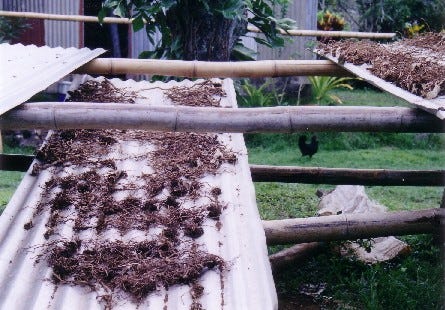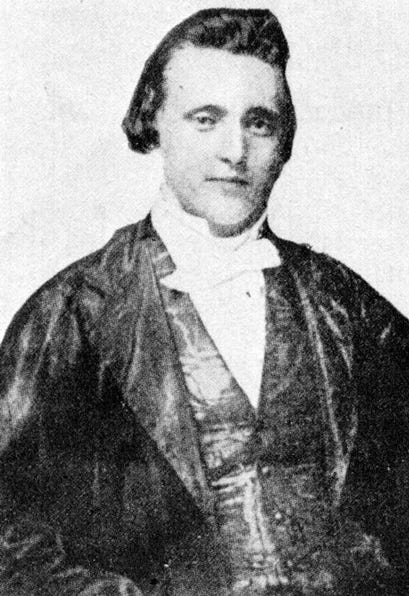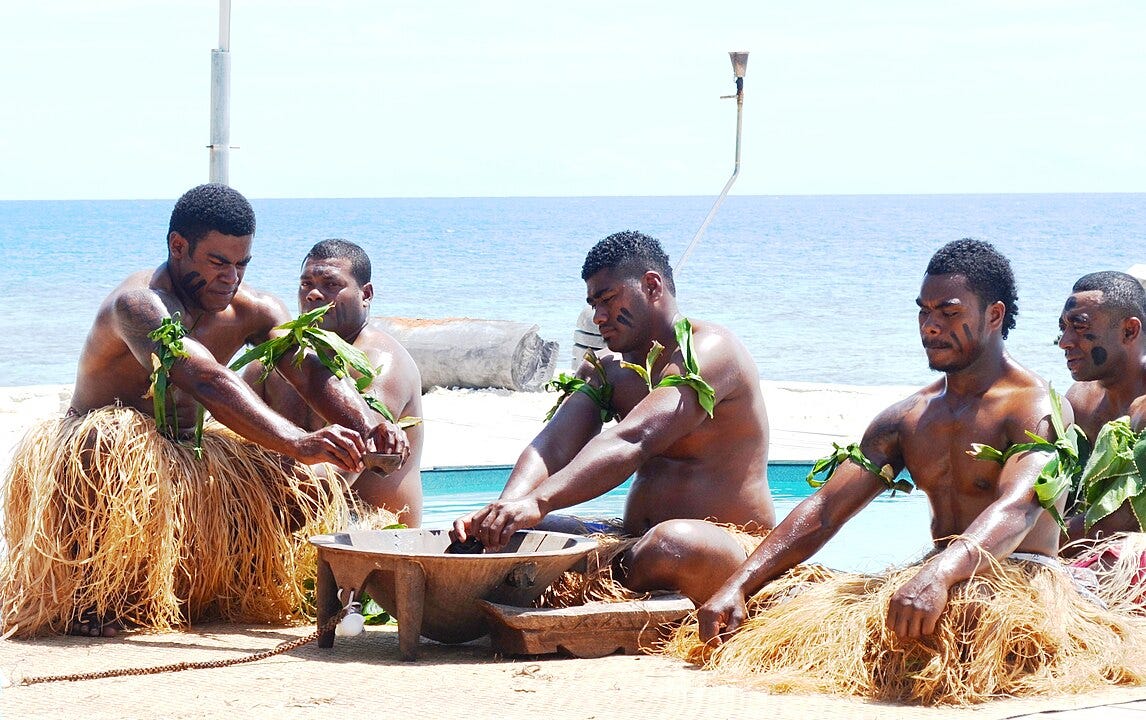Personally I think it tastes like muddy water. I know that from swimming in mud holes during hot Florida summers to cool off when I was too young to know better. The mud pies sucked too. It looks like muddy water as well. But to many Polynesian cultures, it is a sacred root. I first heard about it in Fiji from a guy on the bus. When he learned that my newly acquired travel partner, Nigel, and I were looking for surf in remote locations, he suggested we buy some at the market and take it with us to the villages.

Called yangona when you buy it in the market or bring it as an offering to the village chief, once it is processed to be drunk, the name changes to kava or grog. Piper methysticum is what scientists named it. Yangona is a shrub that is native throughout the South Pacific. The root is what is harvested and has the narcotic, psychoactive chemical compounds called kavalactones. These are extracted by drying the root before pounding it into a powder before it is soaked in water and then filtered. In Fiji, it is drunk during a casual evening with men in a bure or house. Everyone sits in a circle on a mat with legs crossed. The kava is prepared in a large special bowl and then served in cups made from half coconuts that have been sanded and polished.
The first time I witnessed the value that the Fijians placed on this root was arriving to the beach at the village of Marou in the remote Yasawa Group. The two of us were looking for waves by using a free brochure map and had basically been dropped off by the ferry boat captain with a handwritten note. Because we had no real plan where we were going, he chose a place for us. I have no idea what that note said or why he dropped us at Marou. Under my arm along with my surfboard, I had a sevusevu, a gift of yangona for the village chief. When I showed the note and presented the sevusevu to the first man who had approached us, we were immediately taken to stay at his home with his family.
The package just kind of disappeared, but I was soon shown the result of bringing it. Nigel and I were invited to eat with the village chief. Fortunately it was not an elaborate event, he was pretty casual although he dressed in a nice sulu, the Fiji version of a kilt. We arrived in our best surf wear because that is all we had. We were invited into his bure which looked brand new. The floor mat seemed recently woven and large windows on both sides of the bure let in the mid day sunlight which reflected golden off of the palm thatched walls and roof. We all sat together on the floor with our legs crossed, a position that I personally experience as knee torture. The conversation was a kind interview, he wanted to know why we had come to Marou and about our own lives back home. The chief had a ready smile and laugh, you could see he was highly intelligent and curious. The two distinct memories that linger from this experience are that we were told ahead of time to eat everything, it was a level of extreme disrespect to not finish what was served. One of the bowls brought in for us was a light soup which I learned is one of the special dishes served at any Fijian home. This was particularly tasty except that it had been made from a shellfish called Kai, a type of mussel. The broth was excellent, pungent and salty. But the problem of chewing the actual meat presented itself immediately. I watched the chief, who seemed to be chewing and swallowing with delight. Personally, I could not manage to soften it in any way no matter which teeth I chose to attempt to annihilate it with. It was passed fore to aft and back again in my mouth. I began to wonder if it was not some joke that had been played on us as I had learned already that Fijians are practical jokers and love a good laugh. I glanced at Nigel, he was experiencing the same challenge. If you feel like following along at home, simulate by using 4 - 6 rubber bands, washed of course and either chicken broth or vegetable broth depending on your level of veganism. At each window were small faces covered with a wide smile. The nearby children were getting a good show of the two Kaivalagi with the chief. Finally, I just swallowed the meat whole. It felt the size of my fist going down. I made the crucial mistake of looking into the bowl. There were way too many left. I set my mind to the task. Soon the chief was well and done. He sat watching us and pretending to scold the children who would vanish from the windows for a few seconds before staring in again, being overcome with curiosity. With both the chief and the children watching, the battle of the bowl took on a new level of challenge. I remember being desperate enough that I was secretly starting to devise a way to distract the chief and somehow collect the shellfish in my hand to toss out later. The problem was there was nowhere to store them until leaving. My boardshorts had one pocket that had Velcro closed across the top to hold surf wax in. I was barefoot and the t shirt was pocketless. I looked at the window and considered some way to toss them out when he was talking with Nigel. Desperation had taken hold of my mind. There was no way out. I swallowed what seemed like rubber tire chunks and chased them down with the soup. It took extreme self control and acting on the level of Hollywood to show him a face that was enjoying itself. In some kind of athletic trance, I went to work methodically and time lost all meaning except when I realized through a kind of mental fog that the bowl before me had suddenly, almost magically, been completely drained of its contents. Every… last…thing.
The next evidence of the yangona we had brought to Marou was a few days after dining with the chief. We were told excitedly that a kava ceremony was going to happen that night. I had zero idea what that meant. After dinner, Naqau escorted us to another man’s bure. Naqau did not partake of kava, so he introduced us to those already inside. Nigel and I knew to enter any home bowing our heads as a sign of respect. There were already three or four men sitting around a large, carved wooden bowl. It was about 4 inches thick and 2 feet in diameter. Next to the bowl sat one of the men, splashing and kneading with his hands in the water that filled the bowl. It looked to me like he was washing his hands for some reason. We sat and joined the others, once again in the crossed legged, knee snapping position they had all been doing since birth. Inside, my soul was crying for a chair. “Please Dear God can I please have a chair. Please.” was pretty much how it went. The pain soon became so intense that I wanted to scream. One of the men sensed my discomfort, or saw the sweat profuse upon my forehead, and kindly told me that I could sit however I wanted. My legs instantly shot out like they heard him before it reached my ears. In respect, I had to force myself to be cool while inside wanting to yell “ooooh Thank You LORD!” Recovering my consciousness, I now noticed that the bowl guy had a sock in his hands and was massaging it. The men were patiently quiet, just enjoying a moment of hanging out. Soon the bowl operator reached to his side and picked up a gleaming coconut half shell, dipping it into the juice he had made. As welcomed guests, the bowl was passed first to Nigel who was sitting next to the master of ceremony. We had been instructed by Naqau on the way that before we drank from the cup, we must clap our hands. Not just any clap, but by making our palms into cups. This made the clap have a distinct “pop” sound. Just sipping or tasting the kava was not allowed. Once you placed your lips to it, it has to go down in one gulp. I was used to chugging beers in college, so this seemed normal to me. I chugged everything that I drank. No problem. Finally, after finishing and before returning the communal cup, we were told clap again, this time three times. Finally we were to say “mooo theyyyy”, dropping the tone at the end, and give the cup back to the kava maker.
We spent an unknown number of hours happily passing the bowl, talking wherever the conversation went and feeling on the extreme side of mellow. I had a numbness in my mouth, an overall feeling of relaxation and towards the end of the occasion, became extremely sleepy. I found out later that yangona is a mild narcotic. When I saw my fellow kava drinkers later on around the village, we all had a distinct connection from that shared ceremony. I felt closer to them having shared that time together. I could see why in this culture, having the men spend time around the kava bowl would be extremely beneficial to the ties of a close knit society. I was also very pleased that eating anything was not a respectful requirement.

As the ferry boat pulled away from Marou, and we were on our way back to the main island of Viti Levu, our new family and friends stood waving to us from the beach. It was an emotional time for me, their kindness, humble ways and generosity is something that I will never forget. Somewhere about midway back on the ferry voyage, I had a thought occur to me. The tale was famously told as we had travelled around the islands of the missionary Thomas Baker. The Fijian Islands were originally dubbed the Cannibal Isles. Not sure why you would want to come, but God has plans I guess. The religious being the often culturally clueless, relentlessly saving souls that they are, Baker traveled into the interior of the island where we were now headed to. I could see the mountains getting closer. He was eaten after trying to present a village chief with a COMB for his hair. Touching a chiefs head? How insane do you have to be to try that!? I sat on the starboard side of the ferry, the waves splashing off of the side below my feet. “Hmmmm?” I wondered “What IF that Reverend had presented sevusevu, the sacred root to the chief instead of a hair straightener? Maybe his boots wouldn’t have been the only thing left of him?” Too chewy I guess.



